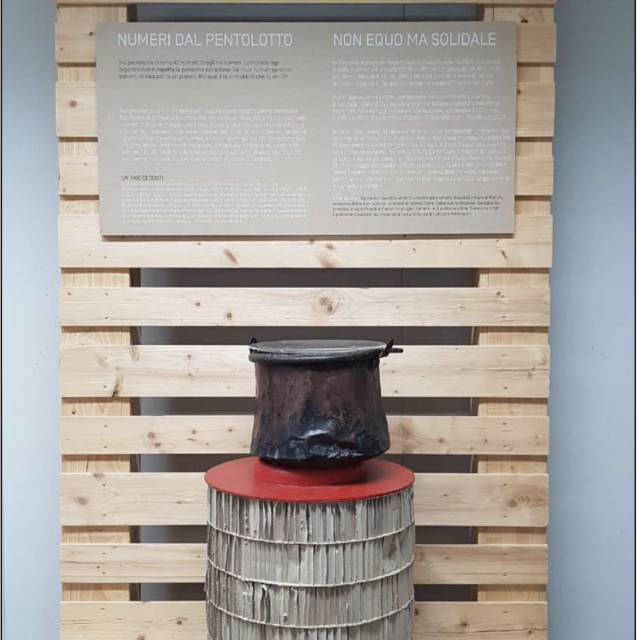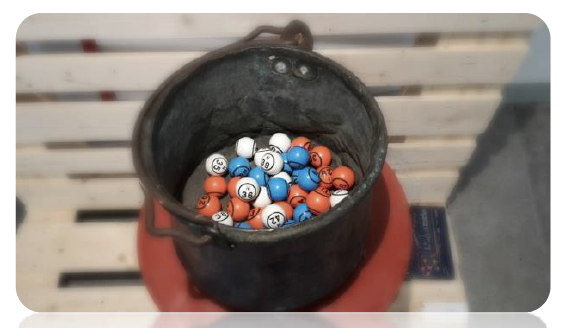The lotto game consists of drawing without re-entry from an urn, some balls all numbered differently. The winner – when there is one! – is the person who will have been able to predict part or all of the numbered balls drawn. In Switzerland, the lotto game was introduced in 1970, and the first million-dollar payout came in 1979. In the beginning it was played with 40 numbers then changed to 42, in 1986 to 45 and since 2013 back to 42, of which 6 numbers are drawn. The probability of guessing 6 numbers out of 42 is 1 in 5,245,786.
How to play
Find a container (for the Numbed by numbers display! we used an old copper pot, like that of a sorceress because the lotto draw is also linked to this magical imagery), place the lotto numbers in the container (42 are the Swiss lotto numbers, 90 are the Italian lotto numbers). The game is very simple. It involves making predictions about the drawing of numbers.
But what is the probability that you will win? Did you play your lucky numbers? Or looking at the latest draws did you decide to play on the numbers that have not come up for the longest time, the so-called ‘laggard’ numbers? Know that only chance decides, there are no tricks or methods. Every number has the same probability of coming out; they are all equiprobables. If we refer to the Swiss lotto, but the reasoning does not change if the amount of numbers changes, the probability of a number coming out is 1 in 42, just over 2 percent. A number can delay even hundreds of draws, but its probability of coming out always remains 1 in 42, neither decreasing nor increasing. These kinds of games have no memory. Yet we are led to believe otherwise.


When playing lotto we are tempted to bet on the numbers that have not come up for the longest time, the so-called “laggard” numbers. Unfortunately, however, it is only chance that decides: there are no tricks or methods, as every number has the same chance of coming out. In the Swiss lotto, the probability of a number coming out corresponds to 1/42, just over 2 percent. A number can also lag hundreds of draws but its probability of coming out always remains 1/42, not increasing, let alone decreasing. This type of game has no memory; yet, we are led to believe otherwise.
But is lotto a fair game? A game is said to be fair if it pays a prize that depends on the probability of winning. In tossing a coin, the probability of guessing whether heads or tails will come out is 1 in 2. The game is fair if betting one franc can win 2. In all other cases, the game is unbalanced, usually in favor of the dealer. Lotto is not a fair game; the banker enjoys an advantage secured by the high number of bets and the unfairness of the odds paid as a premium compared to the probability of winning. Therefore, although the player sometimes wins-even substantial prizes-he is always a loser in the long run.
In the Swiss lotto, for example, what is the probability of guessing 3 out of 42 numbers? Suppose we choose: 2, 11, 29. These can be drawn in 6 different ways, e.g. (6=3!=3x2x1; n!=nx(n-1)x(n-2)x…x1): 2,11,29 – 2,29,11 -29,2,11 – 29,11,2 – 11,29,2 – 11,2,29. How many triplets are possible with 42 numbers? You have to combine 42 objects 3 by 3, in mathematical terms it is equivalent to calculating 42!/(3!x(42-3)!) i.e. (42x41x40)/6=11,480. So the probability of guessing a trio with 42 numbers is 1 in 11,480. Low? With the same calculations we find that the probability of guessing 6 out of 42 numbers is 1 in 5,245,786. It has been calculated that it is more likely that asteroid 99942 Apophis in 2036 will hit the Earth-the probability is 1 in 40,000). But there are so many players that sometimes someone actually guesses them.
In a setup with multiple exhibits, one idea is to have visitors place their bets, perhaps by leaving their “virtual” bets with an entertainer or writing them on a whiteboard with erasable markers, and set 1 or 2 times when the drawing is officially done. After the draw, considerations can be made about the numbers that came out, their probability, useless strategies (lagging numbers,…) that perhaps someone used. The exhibit thus becomes a time of collective sharing, which is much more effective.
What is gambling?
People bet, usually money or goods, on the outcome of a future event. The bet, once placed, cannot be withdrawn. The outcome of the bet is governed by chance. The skill of the player does not count.
In Italy, the oldest lottery dates back to the 16th century and still bears the same name: Lotto. In Genoa, for the first time in Italy, the game of Lotto was legalized in 1576, following a long unrecognized tradition of betting on many events (outcomes of Doges’ elections, marriages, sex of the unborn).
In Italy Betting on horse racing became a popular game of chance with the birth of Totip in 1948.
In Britain in the 12th and 13th centuries, betting on horse racing, now among the most popular forms of gambling, was called “the sport of kings.” But in 1661, the first law banning gambling was enacted, with the aim of preventing less well-off people from getting into debt.
In France the philosopher Blaise Pascal in the 16th century was the inventor of roulette.
In California in 1885 ‘American Charles Fay built the first SlotMachines.
(Source: Arnold P The Enrucionedio of Gomblino Chartwell Books 1977).
Roger Caillois (1913 – 1978) French writer, sociologist, anthropologist and literary critic wrote the best-known Classification of GAME (1962) in which the following definition appears: “ALEA games whose outcome can be determined solely by chance, as in the case of a coin toss, in betting, roulette, lottery… In these kinds of games: player skill is often irrelevant, chance is dominant, risk is always present.”
How to build
- n. 1 Vertical pallet 120×200 cm
- n. 1 Basic pallet 120×80 cm.
- Honeycomb cardboard cylinders with red MDF top.
- A copper pot copper pot (with lot spheres)
- Title cardoboard panel (120×20 cm)
- n. 1 honeycomb cardboard panels with explanation (100×50 cm).
- Lotto balls // Any number of spheres with progressive numbers on them are sufficient; probability calculations will be done on the actual number of spheres. There are various types of spheres, besides the official ones, in different colors or not, the choice is up to the person offering the activity.
